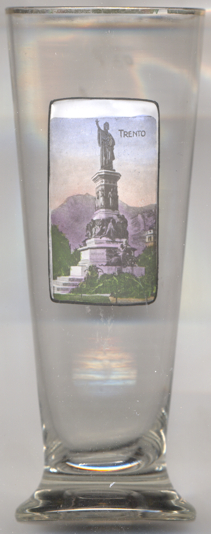

|
| ITALIA | ITALY |
| autonome Region: Trentino-Südtirol / regione autonoma: Trentino-Alto Adige | Trentino – South Tyrol |
| provincia / Provinz: Trento / Trient |
 Trento (German: Trient, Ladin: Trënt) is situated at a elevation of 194 m on the river
Adige (German: Etsch), about 55 km southwest of Bozen/Bolzano and about 100 north
of Verona. Trento is the capital of the Italian autonomous region Trentino-Alto Adige and of the province Trento. The
municipality has a population of about 118,300 (2018).
Trento (German: Trient, Ladin: Trënt) is situated at a elevation of 194 m on the river
Adige (German: Etsch), about 55 km southwest of Bozen/Bolzano and about 100 north
of Verona. Trento is the capital of the Italian autonomous region Trentino-Alto Adige and of the province Trento. The
municipality has a population of about 118,300 (2018).
The origins of the settlement are still a matter odebate. Some sccholars maintain that it was founded by Rhaetians. However,
as the Adige area was influenced by neighouring (Adriatic) Veneti, the Etruscans and Gauls, others maintain that it was
founded by the latter during the 4th century BC. The area was conquered by the Romans in the 1st century who
refounded it as a Roman municipality under the name Tridentum. After the fall of the Western Roman Empire, the
independent bishopric of Trento was conquered by Ostrogoths, Byzantines, Lombards and Franks, finally becoming part of the
Holy Roman Empire. In 1027, Emperor Konrad II created the Prince-Bishops of Trento (Trient), who wielded both temporal
and religious powers. In the following centuries, however, the sovereignty was divided between the Bishopric of Trent and
the County of Tyrol (from 1363 part of the Habsburg monarchy). In the 14th century, the region of Trento was part of
Austria. The dukes of Austria (Habsburg Family) were also the counts of Tyrol and dominated the region for six centuries
(until 1918). In the 16th century, Trento became notable for the Council of Trent (1545–1563) which gave rise to the
Counter-Reformation. Under the reorganization of the Holy Roman Empire in 1802, the bishopric was secularized and annexed to
the Habsburg territories. The Treaty of Pressburg (Bratislava) in 1805 ceded Trento to Bavaria, and
the Treaty of Schönbrunn (Treaty of Vienna) four years later gave it to the Napoleonic Kingdom
of Italy. The population staged armed resistance to French domination. The resistance leader was Andreas Hofer. Hofer
recovered Trento for the Austrians (1809), but he was captured in 1810 and brought to Mantua where he was shot by the
French. With Napoleon's defeat in 1814, Trento was again annexed by the Habsburg Empire. During the late 19th century,
Trento and Trieste, cities with ethnic Italian majorities still belonging to the Austrians, became
icons of the Italian irredentist movement. After World War I, Trento and its Italian-speaking province, along with
Bolzano/Bozen and the part of Tyrol that stretched south of the Alpine watershed (which was
primarily German-speaking), were annexed by Italy. Since the 1950s, the region has enjoyed prosperous growth, in part due to
its special autonomy from the central Italian government.
The
[https://de.wikipedia.org/wiki/Trient, https://en.wikipedia.org/wiki/Trento;
https://de.wikipedia.org/wiki/Dante-Denkmal_(Trient)]
 monument for Dante Alighieri [left] was created in the late
19th century as a symbol for the Italian culture of the Trentino region, at that time still part of the
Austro-Hungarian monarchy. The first ideas were already formed in 1886 when the Pro Patria foundation was founded in
Rovereto. When the 'German' monument for Walther von der Vogelweide was created in
Bozen/Bolzano in 1889, the idea for an 'Italian' counterpart in Trento was again
pursued. After a contest, the (slightly modified) project of Cesare Zocchi was selected. The foundation stone was laid in
1893. The monument was finally completed in 1896.
monument for Dante Alighieri [left] was created in the late
19th century as a symbol for the Italian culture of the Trentino region, at that time still part of the
Austro-Hungarian monarchy. The first ideas were already formed in 1886 when the Pro Patria foundation was founded in
Rovereto. When the 'German' monument for Walther von der Vogelweide was created in
Bozen/Bolzano in 1889, the idea for an 'Italian' counterpart in Trento was again
pursued. After a contest, the (slightly modified) project of Cesare Zocchi was selected. The foundation stone was laid in
1893. The monument was finally completed in 1896.
![[scale]](lineal.jpg)